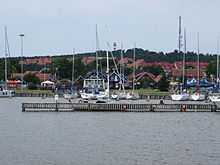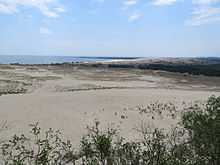Nida, Lithuania

Nida (German: Nidden) is a resort town in Lithuania, located on the Curonian Spit. It has 1,650 residents and is the administrative center of the Neringa municipality. Nida Airport is located in the town. Nida is the westernmost point of Lithuania and the Baltic States.
History
First mentioned by Teutonic Order in macher colony documents in 1429 and 1497, the settlement was originally 5 km south of today's position near the Hohe Düne (high dune) at Grabscher Haken (Old Prussian grabis = hill). The fishing village became part of the Duchy of Prussia in 1525 and the Kingdom of Prussia in 1701.

Continuously threatened by sand drifts, the village was moved away from the dune to today's position in the 1730s. In 1874 a lighthouse on Urbas hill was built, later destroyed in the war and rebuilt in 1945 and 1953.
In the beginning of 20th century, Nidden became famous as a colony of German expressionists (Künstlerkolonie Nidden). Artists such as Max Pechstein, Alfred Lichtwark, Karl Schmidt-Rottluff, and Alfred Partikel visited Nidden.[1] Painters from Königsberg such as Julius Freymuth and Eduard Bischoff stayed in the area, as did poets like Ernst Wiechert and Carl Zuckmayer.[1] Other guests included Ernst Kirchner, Ernst Mollenhauer, Franz Domscheit, and Herrmann Wirth. The painters usually took accommodations at the Herman Blode hotel, and left some of their works with him.

Nidden became part of Lithuania together with the northern half of the Curonian Spit in 1919 after World War I and was officially renamed Nida. Nevertheless the village remained a German-majority settlement - the border with East Prussia's half of the Spit lay only a few kilometres to the south. Nobel Prize-winning writer Thomas Mann lived in Nida during the summers of 1930–32. Part of Joseph and His Brothers (Joseph und seine Brüder) was written here. Mann's summer cottage survived and in the Soviet era hosted a library open in summer only, with residential quarters of the visiting librarian posted from Klaipėda upstairs and public areas downstairs. It is presently a culture center dedicated to the writer, with a memorial exhibition.
The town is known for Nidden Kurenwimpel, ornate carved flags peculiar to local families resident on the Curonian Spit. The flags, replicas of which can be seen around Nida, feature animal and human figures as pictograms reminiscent of a pagan writing tradition. At the local cemetery, examples of krikštas (pl. krikštai), pagan burial markers in place of tombstones, can still be seen today.
In 1939 the town had 736 inhabitants.[1]

Nida became nearly uninhabited, like all of the Curonian Spit, as a result of the evacuation of East Prussia during World War II. The town was returned to the Lithuanian SFSR within the Soviet Union by the 1945 Potsdam Agreement, and today (since 1990) is part of independent Lithuania.
Nida was a little-visited fishing village in the post-war period. Jean-Paul Sartre and Simone de Beauvoir went to Nida during their stay in Lithuania in the summer of 1965. In the 1970s, together with three other villages of the Neringa municipality (Juodkrantė, Preila and Pervalka), it was reserved as an invitation-only holiday resort with a controlled entry regime and accommodation reserved almost exclusively for the Communist party nomenklatura and senior government and industry elite. Thanks to the very strict planning regulations and a ban on any industrial development and more generous municipal subsidies, it remained an unspoilt and clean territory. Today, the number of visitors is kept small by the low number of available hotel rooms (as new developments are limited, and are usually permitted only on already existing old buildings foundations), relatively high accommodation prices, ferry tolls, and entry pass costs.
Tourism
The town is an upmarket holiday resort, hosting about 200,000 to 300,000 tourists each summer, mostly Lithuanians, Germans, Latvians, and Russians. It is characterized by low-key entertainment and a distinct family focus. However during recent years it become a decent point of interest for fine electronica music and modern art shows at an eclectic forest retreat.
Since 2000, a jazz festival has been held every year. A local radio station Neringa FM streams live beats over FM and online. There are also interesting places to see nearby, including some of the highest sand dunes in Europe, a large sundial (which has now been restored after being damaged by a Baltic gale), fisherman's ethnographic museum, gallery-museum of amber, neo-Gothic church (built in 1888). There is also a campsite.
Nida's beach participates in the Blue Flag Programme.
Economy
Transportation
Nida has a port which is used for ferries and fishing boats.
Gallery
-
Curonian flag from Nida
-

Krikstas - pagan burial marker
-

Old cemetery
-

Small inn and cafe in Nida
Notes
References
- Weise, Erich (1981) [1966]. Handbuch der historischen Stätten Deutschlands, Ost- und Westpreussen [Handbook of places in Germany, East and West Prussia]. Kröners Taschenausgabe, Band 317 [Kröners pocket book edition, volume 317] (in German) (Reprint of the 1966 ed.). Stuttgart: Alfred Kröner Verlag. ISBN 978-3-520-31701-8. OCLC 36315021.
External links
 Media related to Nida at Wikimedia Commons
Media related to Nida at Wikimedia Commons
Coordinates: 55°18′N 21°00′E / 55.300°N 21.000°E
.JPG)